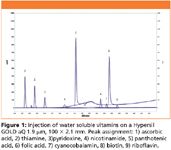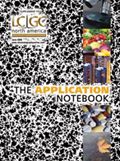Fast Analysis of Water-Soluble Vitamins
This application note describes a fast LC method for the analysis of water-soluble vitamins using a Thermo Scientific Hypersil GOLD aQ column.
This application note describes a fast LC method for the analysis of water-soluble vitamins using a Thermo Scientific Hypersil GOLD aQ column.
Water-soluble vitamins represent a group of various, essential dietary compounds, which are classified by their biochemical activities, not their physico-chemical properties. A single vitamin generally is formed by several vitamers (various chemical species, each of which displays the same biological activity). As a result of their different chemical properties, it can be difficult to reliably analyse vitamins.
The method in this application note describes the use of a 1.9 μm particle size, polar endcapped C18 stationary phase to allow the fast and efficient chromatographic determination of nine water-soluble vitamins.
Materials and Method
Chromatographic conditions
Column: Hypersil GOLD aQ™ 1.9 μm, 100 × 2.1 mm
Part number: 25302-102130.
Mobile phase: A – 50 mM KH2PO4 (pH 3.5): MeOH (95:5)
B – 50 mM KH2PO4 (pH 3.5): MeOH (5:95)
Gradient: 0 to 100% B in 3.8 min
Flow rate: 0.5 mL/min
Temperature: 30 °C.
Detection: UV at 205, 254 and 280 nm
Injection volume: 0.5 μL
Standards: 1) Ascorbic acid, 2) Pyridoxine, 3) Nicotinamide, 4) Panthotenic acid, 5) Folic acid, 6) Cyanocobalamin, 7) Thiamine, 8) Biotin, 9) Riboflavin
Standard stock solution concentrations: 1 mg/mL. Standards were dissolved in methanol, except for pyridoxine, panthotenic acid, and riboflavin, which were dissolved in water. Folic acid and biotin were prepared in water + 50 μL 1 M NaOH.
Standard working solution concentrations: 100 μL/mL. All standards were diluted in water.
Results and Discussion
Most water-soluble vitamins are assayed in reversed phase HPLC with UV detection. However, since many water-soluble vitamins are polar, their analysis requires high separation selectivities and high retention capabilities. These characteristics can be achieved thanks to the polar endcapping technology used in Hypersil GOLD aQ, which combines C18 retention with additional controlled interaction mechanisms, responsible for superior retention of polar analytes.
The polar endcapping also helps to prevent phase collapse, permitting the use of highly aqueous mobile phase at the start of the gradient and so allowing retention of ascorbic acid away from the solvent front. The separation selectivity offered by Hypersil GOLD aQ 1.9 μm, 100 × 2.1 mm, is presented in Figure 1. Compared to columns packed with 5 μm or 3 μm particles, the use of 1.9 μm particle size allows operation at higher flow rates without loss in chromatographic efficiency. This means that faster analysis can be performed and full separation of the nine vitamins was achieved in less than 3 min.

Figure 1
Conclusions
Hypersil GOLD aQ, with its C18 bonding and polar endcapping technology provided suitable interaction mechanisms to separate a range of water-soluble vitamins, which have different degree of polarity. The use of 1.9 μm particle size allows fast analysis. It was possible to achieve full separation of the nine vitamins in just under 3 min.
References
(1) L.F. Russell, Quantitative determination of water-soluble vitamins. In: L.M.L. Nollet ed. Food analysis by HPLC. New York, Marcel Dekker, 2000, 403.

Thermo Fisher Scientific, Inc.
112 Chadwick Road, Runcorn, Cheshire, UK WA71PR
tel. (011)44-1928-581-000
Website: www.thermo.com

The Benefits of Custom Bonded Silica
April 1st 2025Not all chromatography resins are created equal. Off-the-shelf chromatography resins might not always meet the rigorous purification requirements of biopharmaceutical manufacturing. Custom bonded silica from Grace can address a wide range of separation challenges, leading to real performance improvements. Discover more about the latest innovations in chromatography silica from Grace, including VYDAC® and DAVISIL®.
5 Things to Consider When Selecting a Chromatography Silica
April 1st 2025Particularly in the pharmaceutical industry, drug purity isn’t just a goal – it’s essential for achieving safety, stability and efficacy. However, purification is easier said than done, especially with challenging molecules like DNA and RNA “oligonucleotides,” due in large part to their diversity and the range of impurities that can be generated during production. Enter DAVISIL® chromatographic silica, with a wide range of pore diameters and particle sizes to meet your specific application, performance and sustainability requirements. Before you choose the chromatography resin for your next purification application, take a look at these 5 considerations.
Automating Protein Purification: Efficiency, Yield, and Reproducibility
March 27th 2025Recent advancements in automated protein purification stress the importance of efficiency, scalability, and yield consistency. This eBook compares different purification platforms, highlighting their impact on downstream applications and demonstrating how automation enhances throughput and process control.
MilliporeSigma: Ultrapure Water for Sensitive LC-MS Analysis of Pesticides
March 25th 2025The aim of the study was to illustrate the efficiency of Milli-Q® water purification systems in eliminating pesticides from tap water, thereby producing and delivering reliable and consistent-quality ultrapure water suitable for pesticides analysis















